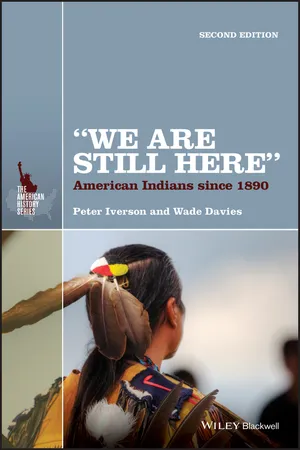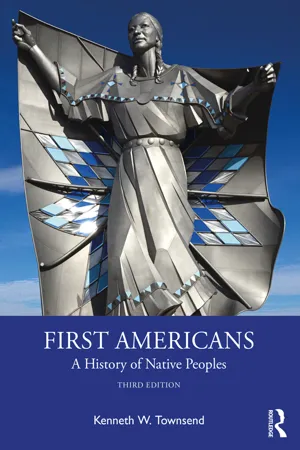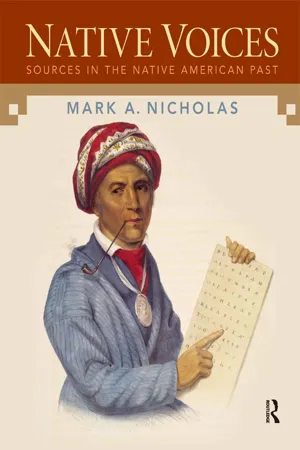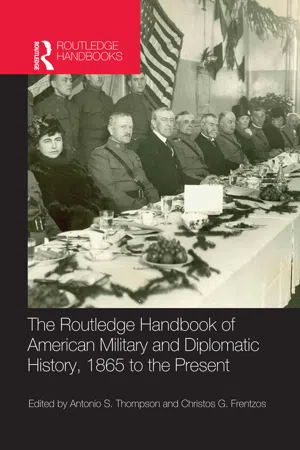History
Native Americans in WW2
During World War II, many Native Americans served in the military, contributing their unique skills as code talkers, scouts, and soldiers. Despite facing discrimination and challenges, their contributions were significant and helped to achieve victory. Additionally, the war experience led to increased awareness of Native American issues and paved the way for advancements in civil rights for indigenous peoples.
Written by Perlego with AI-assistance
Related key terms
Related key terms
1 of 4
Related key terms
1 of 3
4 Key excerpts on "Native Americans in WW2"
- eBook - ePub
"We Are Still Here"
American Indians Since 1890
- Peter Iverson, Wade Davies(Authors)
- 2014(Publication Date)
- Wiley-Blackwell(Publisher)
He did not know the satisfaction or hear the accolades Native men and women received from their many contributions to the national effort. But he would be remembered, and his particular story would be told. There are many American Indian narratives from the war and, of course, no single one is representative of that collective experience. Many of those stories involved struggle and death. Some emphasized tragedy, some survival, others triumph. Now, many decades after the war's end, they continue to be repeated, and they still hold lessons about the significance of the war years. They suggest that in some ways the era yielded a kind of turning point in the modern Indian experience. In Speaking of Indians, published in 1944, Ella Deloria (Yankton Sioux) observed: “The war has indeed wrought an overnight change in the outlook, horizon, and even the habits of the Indian people—a change that might not have come for many years yet.” However, this period also often accentuated or emphasized trends already under way in individual lives and in the communities that Native peoples called home. American Indians had not been completely isolated before 1941. Many had left reservation environments to attend school; others had gone to the city to work. Federal programs had left their mark on tribal government, land use, education, and health care. Nonetheless, the war allowed countless thousands of Indians to perceive and experience the larger society of America. These perceptions and experiences, in turn, affected individual and group decisions about life in the postwar era. World War II and Its Consequences Although many Native Americans rushed to volunteer for the war effort, others resisted the demands of the Selective Service Act of 1940. Now that all Indians were citizens, they all faced the draft. Even the Iroquois in New York who supported the United States' cause, for example, questioned the authority of the federal government to force men to fight - eBook - ePub
- Kenneth W. Townsend(Author)
- 2023(Publication Date)
- Routledge(Publisher)
Table 15.1 ).Table 15.1Native American Servicemen, Spring 1945ArmyNavyMarine CorpsCoast Guard21,767*1910*723*121** Figure does not include Commissioned Officers.Source: Department of the Interior, Indians at War. Washington, D.C.: Government Printing Office, 1945.Seeing HistoryFreedom’s Warrior—The American IndianCharles Banks Wilson, born in 1918, devoted much of his career as a professional artist to capturing on canvas the history of Oklahoma and its prominent citizens. He also published books about the American West, the Texas Rangers, and Native Americans, among them Indians of Eastern Oklahoma (1956). His masterful portraits of Will Rogers and Jim Thorpe along with his paintings of the people and landscape of the state hang in the Oklahoma State Capitol building. In 1995, at the age of 77, Wilson painted Freedom’s Warrior—The American Indian to honor the service of Native Americans to the United States in times of both war and peace.Questions
- What perspective or theme does Wilson portray in this piece representing Native American service during World War II?
- In what ways does the artwork mirror the wartime rhetoric of American policymakers, military personnel, and press concerning Native American participation in World War II?
15.2 Charles Banks Wilson, Freedom’s Warrior—The American Indian.Source: Courtesy of Library of Congress Prints and Photographs Division, LC-USZ62-87996Defining Indian Identity
The United States portrayed the war as the ultimate conflict between good and evil, between the forces of God and Satan. Although Americans of every faith answered the call to war, Protestant governing bodies hesitated to offer official sanction for military action until summer 1942 when each, reluctantly and with very liberal interpretations of biblical teachings, validated armed force as the nation’s only recourse. Even then, not all devout Christians relinquished their fundamental doctrine of peace and brotherhood. Thousands of American citizens placed their religious identity above their national identity and refused induction into the armed forces. The Selective Service System exempted from conscription anyone “who, by reason of religious training and belief, is conscientiously opposed to participation in war in any form.” More than 70,000 individuals filed applications for conscientious objector - eBook - ePub
Native Voices
Sources in the Native American Past
- Mark Nicholas(Author)
- 2016(Publication Date)
- Routledge(Publisher)
Section 19. The term “Indian” as used in this Act shall include all persons of Indian descent who are members of any recognized Indian tribe now under Federal jurisdiction, and all person who are descendants of such members who were, on June 1, 1934, residing within the present boundaries of any reservation, and shall further include all other persons of one-half or more Indian blood. For the purposes of this Act, Eskimos and other aboriginal peoples of Alaska shall be considered Indians. The term “tribe” wherever used in this Act shall be construed to refer to any Indian tribe, organized band, pueblo, or the Indians residing on one reservation. The words “adult Indians” wherever used in this Act shall be construed to refer to Indians who have attained the age of twenty-one years.Approved, June 18, 1934. ■WORLD WAR IIIn 1939, war broke out overseas when Adolph Hitler and Nazi Germany began a campaign to control all of Europe. In 1940, the United States instituted its first peacetime draft. By 1941, 42,000 Native American men had enlisted with the armed forces. The rate of enlistment would have far exceeded that number if the civil service had not rejected over one-third of potential Indian enlistees. The war provided many unique opportunities—economic, political, cultural, and social—for Indian men to enlist. Although the Indian New Deal had partially staved off the crushing devastation of the depression, enlisting provided Native American men with jobs and wages. Some Indian men saw in the war an opportunity to revive dying “warrior cultures” among their communities. Increasing status and prestige, once the preserve of young men who asserted themselves as warriors, no longer existed among Indian communities. The war was a golden opportunity for young Indian men to go overseas as strong, masculine warriors, only to then return home with the hopes that a uniform and medals would win them new recognition within their communities.Excerpts provided in this section capture the range of Native American experiences during World War II. The most famous of Native American enlisted men were the Navajo code talkers. Many served on the front lines in the Pacific Theater against the Japanese. The Navajos innovatively used their language to create a code for America’s military forces to transmit important war information. The best minds from the opposition’s forces never broke the Navajo code. The first selection is from a Navajo code talker recollecting his participation in the war effort. Document 4–8 contrasts that of the famous Navajo code talkers. Non zhín - eBook - ePub
The Routledge Handbook of American Military and Diplomatic History
1865 to the Present
- Christos Frentzos, Antonio S. Thompson(Authors)
- 2013(Publication Date)
- Routledge(Publisher)
22Indian veterans returned home with pride, with self-confidence, and with a greater sense of national belonging and acceptance. Wartime experiences had broadened their outlook on life, and many were able to translate their training and newly acquired skills into better jobs and a more secure future at home. Others struggled to readjust to reservation life—haunted perhaps by the recent atrocities they had witnessed on the Western Front. Just a few decades earlier, many Americans had accepted the contention that Indians were a “Vanishing Race” and that their “inherent” backwardness and unwillingness to accept assimilation would doom them to inevitable extinction. Service during the war, however, offered convincing proof that Native Americans were vibrant and persevering peoples who had much to offer the majority culture. Viewed in this light, the war years may have helped hasten the evolution of popular misconceptions from the “Vanishing Race” scenario back to other stereotypes that glorified the martial and virile attributes of Indian men—stereotypes that had important consequences for Indian soldiers and the types of duties they performed in World War I and in future wars.23Native Americans also made substantial contributions on the home front. Reservation families were active in Red Cross work, and several thousand Indian families bought Liberty bonds and war stamps. Indian women knitted socks, mufflers, sweaters, and hospital garments for American soldiers, while Indian farmers stepped up production of agricultural products. For many tribes, the war years brought about a renewal of customs and traditions they had not practiced in a generation. Indian veterans of World War I, for example, returned home to purification rituals, victory dances, feasts, and giveaways. A fortunate few even gained admittance to previously inaccessible warrior societies that required young men to demonstrate bravery on the battlefield. Other veterans returned home bearing deep physical and emotional scars that undermined their reintegration into society. Military service during World War I, therefore, can be seen as a catalyst for cultural renewal among Indian peoples, an irony considering the goals of policymakers who had hoped that military service would encourage assimilation.24
Index pages curate the most relevant extracts from our library of academic textbooks. They’ve been created using an in-house natural language model (NLM), each adding context and meaning to key research topics.
Explore more topic indexes
Explore more topic indexes
1 of 6
Explore more topic indexes
1 of 4



